This week, we’re joined by vehicle designer Dan Sturges to talk about his book, Near to Far: A Design for a New and Equitable Transportation System. We talk about new ways of thinking about vehicle design, mobility for low-density areas, as well as pop culture perceptions of small vehicles. It’s a big deal.
Many people prefer to read than hear, so if you want full transcript, click here. A shorter excerpt is below the player:
Here’s the edited section:
Jeff Wood: I want to talk a little bit about smaller vehicles. You’ve worked with Segway, but I think the frustrating thing is you can design these vehicles but the marketing and the public perception of them can be twisted by pop culture. The Segway had trouble because people expected it to be something that it wasn’t. Then you have Wall-E, which is an example of Pixar pointing out people on pods. And so that turns into what people’s main idea of pods — and that is single occupancy small vehicles. So what’s your feeling about some of the public perception missteps that have been happening about smaller electric vehicles that could be really useful?
Dan Sturges: It’s great that you bring up Wall-E one in particular — it’s been a real thorn in my side. I’m friends with Jay Schuster who designed Wall-E at Pixar. Segway was pretty unfortunate. This book came out and they started talking about Steve Jobs and Jeff Bezos seeing this vehicle. They didn’t tell us what it was, but it was gonna change our world. And for most Americans or people in our country, their transportation is an automobile that not only does local travel, but it takes them on the highway, gets them everywhere they need to go around their city or their region. So I think people were imagining hovercrafts or things that levitate — I don’t know what people were imagining — but they thought something radical was coming in when they revealed the vehicle on Good Morning America.
It’s a 13-mile-an-hour very high tech scooter and people were really let down, right? Then they wanted to go on the sidewalk and then people said, “Oh well it’s replacing walking.” Ultimately if you support an e-bike, you should be able to support a Segway. It’s just a very teeny vehicle that takes teeny amount of electricity that can move you down a path so much more efficiently in terms of using very little space. In fact, Elon Musk told the industrial designer for the Segway to his face that he thinks the Segway is ridiculous. That’s not good because the Segway probably gets the equivalent of a thousand miles per gallon and it’s teeny — and it’s more efficient than any Tesla will ever be for a short trip.
And Wall-E Mobile, which they show on this spaceship city where everybody is very fat and heavy with their Big Gulp on their computer screen, was really unfortunate because first off, that spaceship lacked was any active corridors — it didn’t have any places for people to walk or bike. And so everyone was on this hover chair, as they call it. And so when I show what I call a “seat-mobile,” people go, “Oh, I’m gonna get fat on that.” And I’m like, are you kidding me?! Go to downtown San Jose — someone comes off the highway in their Tesla or Audi and now they’re going to go at 25 miles an hour just one or two miles towards their destination off the highway.
Well if they had gotten out of that Tesla or that Audi in that five seat big car and got into that little Wall-E vehicle, they would’ve saved so much land. You could have actually, if everyone was doing that, you could make your bike lanes five times wider than what we do now, if people would get out of that big car and take the little Wall-E mobile that last mile. But no, everyone saw the movie and they think, “Oh this teeny vehicle’s going to get me fat.” But the fact that they’re in the Tesla or the Audi going that last mile, oh, that’s not going to make them fat? They’re just taking four empty chairs everywhere they go and taking up this huge piece of land. It’s just absurd.
But as humans, somehow our mindset is still so stuck in this automobile culture — and the inertia of our automobile culture is just massive. It’s the ingrained idea that this car just takes us everywhere. I talked today with Dave Brook, who started the first car share in the United States in Portland in 1997. And to date, we only have like 20,000 car-share vehicles in the United States out of almost 300 million cars.
That is not a lot of success. So we’re having a problem with our mindsets on this.






